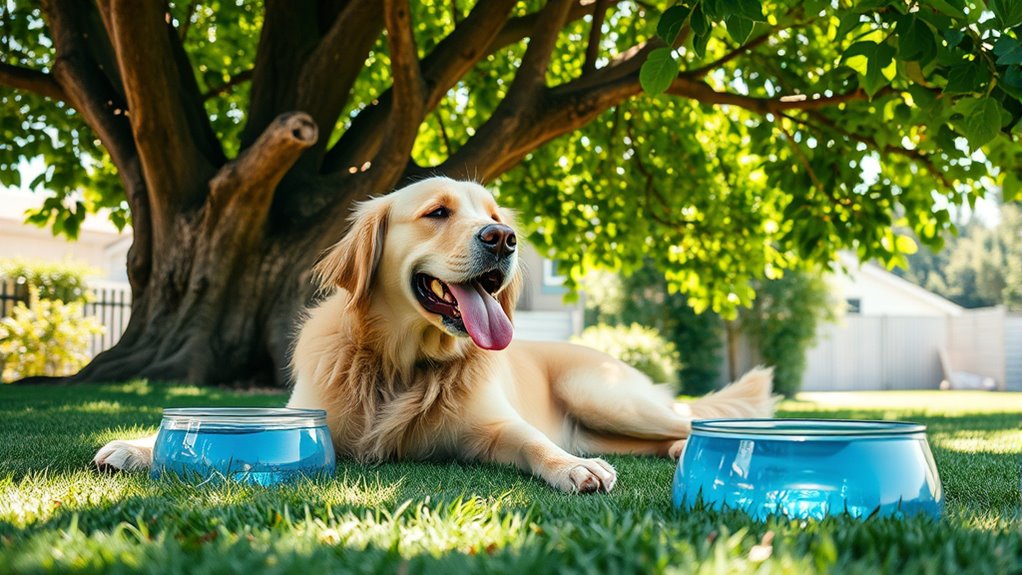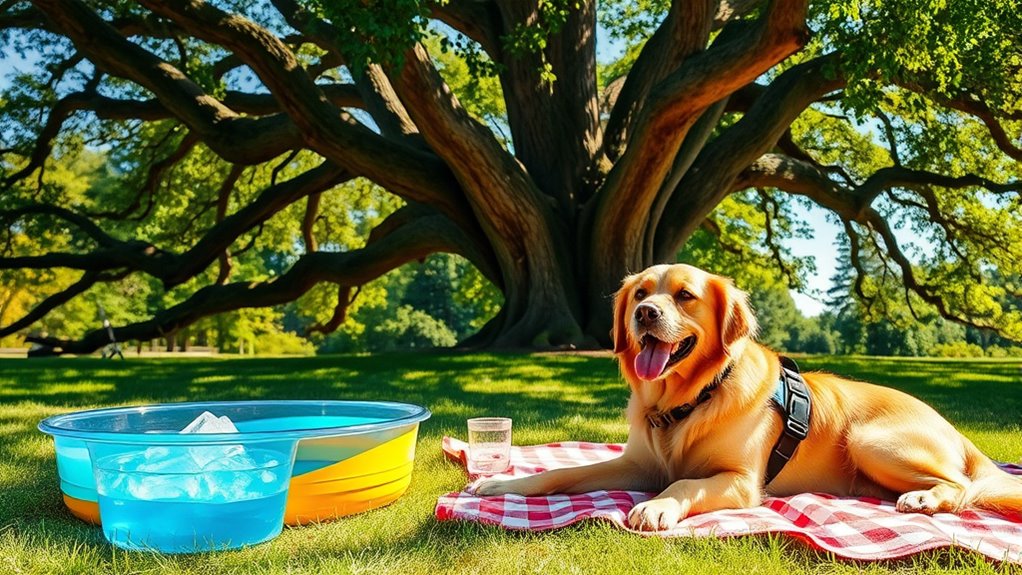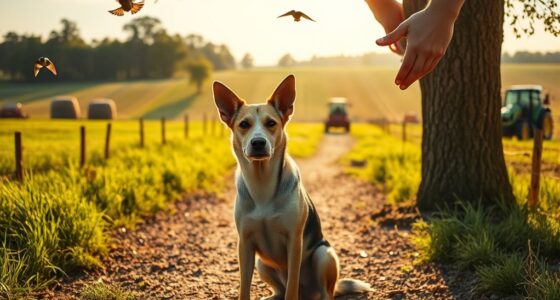To keep your dog safe in hot summers and prevent heatstroke, always walk during cooler times like early mornings or late evenings, and choose shaded or grassy paths. Protect their paws with booties or balm, and carry plenty of water to keep them hydrated. Watch for signs of overheating such as heavy panting or lethargy. Ensuring their environment stays cool and shaded is key—continue to discover more ways to keep your furry friend safe in the heat.
Key Takeaways
- Walk your dog during cooler times like early mornings or late evenings to avoid heat exposure.
- Protect paws with booties or paw balm and check for burns or redness regularly.
- Always carry fresh water and encourage frequent hydration to prevent dehydration and heatstroke.
- Provide shaded spots and limit strenuous activities during peak heat hours.
- Watch for signs of overheating such as excessive panting, drooling, or lethargy, and cool your dog immediately if needed.

Are you aware of how swiftly a hot summer day can turn dangerous for your dog? When the temperature rises, your furry friend’s safety depends on your awareness and proactive measures. One of the essential aspects of keeping your dog safe is ensuring paw pad protection. Hot pavement, sand, or asphalt can quickly burn sensitive paw pads, leading to pain and potential infections. Before taking your dog out for a walk, test the surface by pressing your hand against it for a few seconds. If it’s too hot for your hand, it’s too hot for their paws. To protect them, consider walking during cooler parts of the day, like early mornings or late evenings, and stick to grassy or shaded paths when possible. You might also invest in protective booties that shield their paws from hot surfaces, or apply paw balm designed to create a barrier against the heat. Regularly check their paws during walks for redness, blisters, or debris, and rinse their paws with cool water afterward to remove any residual heat or irritants.
Hydration strategies are equally essential in preventing heat-related issues. Dogs can’t sweat like humans do, so they rely heavily on drinking water to cool down. Always carry a portable water bowl and fresh water with you when going outdoors. Encourage your dog to drink frequently, especially during walks or playtime, and watch for signs of dehydration, such as excessive panting, drooling, or lethargy. Providing ample water not only keeps them hydrated but also helps regulate their body temperature. Ensure their water bowl is clean and filled regularly when at home, and consider adding ice cubes to their water on extremely hot days to keep it cool longer. If your dog is particularly active or has a thick coat, you may need to increase their water intake even more. Remember, dehydration can set in quickly and lead to heatstroke, so being vigilant about hydration is essential. Additionally, provide shaded areas where your dog can rest and cool down, and avoid strenuous exercise during peak heat hours.
Frequently Asked Questions
Can Certain Dog Breeds Tolerate Heat Better Than Others?
You might wonder if some breeds tolerate heat better than others. Breed resilience varies, with some breeds naturally adapting better to hot weather. Coat types play a role too; short-haired or thin-coated breeds tend to handle heat more effectively than those with thick or double coats. Knowing these differences helps you choose and care for your dog appropriately, ensuring they stay comfortable and safe in warmer temperatures.
How Do I Recognize Heatstroke Symptoms in My Dog?
Imagine your dog suddenly collapses after a walk on a hot day. You notice it panting heavily and drooling excessively. These are key signs of heatstroke. You should also watch for rapid heartbeat, weakness, vomiting, or even uncoordinated movements. If you see these symptoms, immediately move your dog to a cooler area, offer water, and seek veterinary help. Quick action can save your dog’s life.
Is It Safe to Walk My Dog During Peak Midday Heat?
Walking your dog during peak midday heat isn’t safe because the pavement can burn their paws and overheating is likely. Instead, seek shade safety and walk early mornings or late evenings when it’s cooler. Make sure to hydrate your dog frequently, providing fresh water during breaks. This helps prevent heat exhaustion and keeps your dog comfortable and safe, even when temperatures climb.
What Are the Best Cooling Accessories for Dogs in Summer?
Imagine turning your dog’s summer into a breeze-filled paradise. Cooling mats act like a revitalizing pond, offering a cool spot to rest, while portable fans create a gentle windstorm at their side. These accessories turn hot, stuffy days into cool escapes. By using cooling mats and portable fans, you help your furry friend stay comfortable and safe, making summer adventures fun instead of a heatwave they dread.
How Can I Prevent Heat Exhaustion During Outdoor Activities?
To prevent heat exhaustion during outdoor activities, you should focus on hydration strategies and finding shady resting spots. Bring plenty of water and encourage your dog to drink regularly, especially on hot days. Take frequent breaks in shaded areas to help your dog cool down and avoid overheating. Watching for signs of fatigue or discomfort allows you to act quickly, keeping your dog safe and comfortable during outdoor adventures.
Conclusion
As summer temperatures soar, remember that dogs are vulnerable to heatstroke—an emergency that can be deadly. Did you know that heatstroke accounts for nearly 50% of all preventable pet deaths during hot months? By keeping your dog hydrated, avoiding peak heat hours, and never leaving them in a parked car, you can protect your furry friend. Stay vigilant and proactive—your dog’s safety depends on it, so enjoy summer responsibly together.










